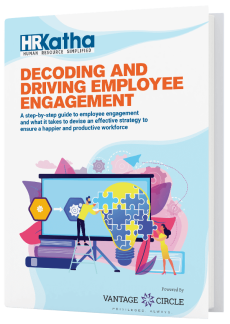Employee Survey Fatigue: A Mini Guide

A company that prioritizes and incites a culture of feedback has- at one point- experienced the perils of employee survey fatigue.
Don't get me wrong. Employees feel valued when their concerns are actively heard and responded to in the right manner. In turn, relevant and thoughtful feedback can be the simplest way to pinpoint your company's strengths and weaknesses.
But everything good comes at a price. With employee surveys, it is the eventual fatigue and disinterest that sets in among survey respondents.
The greater the survey fatigue, the more distorted and false the survey results will be. Thus, in this article, we'll be attempting to understand the phenomenon of survey fatigue in detail.
However, it is hardly the fault of your annual employee engagement survey. The fault lies in how and when the survey is sent across to the employees. Are there any better ways to simplify the process and get employee feedback that actually matters? Let's have a look.
What Is Employee Survey Fatigue?

The survey fatigue definition can be explained as the follows:
Survey fatigue occurs when respondents are frustrated or drained by the number of surveys or the number of questions they need to complete.
The same can be said for employee survey fatigue too. Employees experiencing respondent fatigue will affect the company culture in the following ways:
- Encourage giving the wrong employee feedback
- Affecting the scores of metrics such as employee engagement levels
- Negative impact on the quality of response and data
- Low motivation and morale among workers
- Waste of money, time, and resources
As we can see, the results are not pretty. Because of survey fatigue, your plan of creating a feedback culture can go haywire. Several companies' bottom line has been negatively impacted due to this fatigue.
Thus, it's vital to understand the types of survey fatigue and identify which one your workforce is experiencing right now.
Types Of Employee Survey Fatigue

The types of survey fatigue vary from source to source. In some organizations, it might be because the surveys are too long. In other cases, it might be because no actions are taken after the feedback is gathered. All in all, it's a manager or HR's job to identify which type of employee survey fatigue your employees are experiencing.
Type 1: Over Surveying Fatigue
This type of respondent fatigue is seen in employees who are repeatedly asked to take one survey after the other. It is necessary to use employee surveys sparingly and to choose ample time between sending two such surveys.
Type 2: Question Fatigue
Question fatigue occurs when there are long and challenging questions in the employee survey. Such questions make the experience of taking a survey highly tiresome and dull.
Type 3: Long Survey Fatigue
Employee surveys that are overly long can make workers feel drained and disengaged while answering the questions. Additionally, long surveys often tends to stray away from the core areas of focus.
Type 4: Insincere Survey Fatigue
It happens when workers think or see that the management doesn't take their opinions seriously. In such situations, it is often found that businesses fail to act on the shortcomings revealed by the survey results.
5 Things To Do To Reduce Employee Survey Fatigue
To place value on employee feedback, it should be well reflected in the survey process. The following tips will help you address the root cause of employee survey fatigue and boost the participation rate in the meantime.
1. Plan, Plan, Plan

As with any project, the success of a survey lies upon its planning. Before deploying any survey to your workforce, you must consider some technicalities of it, such as:
a. The aim of the survey
Ensure that you understand the reason behind sending the survey. Is it for an exit interview? An onboarding survey? Or to measure the employee satisfaction levels? Each purpose will require the survey to focus on a specific set of questions.
b. The frequency of the survey
As mentioned before, there is such a thing as too many surveys. It's crucial to decide the frequency of the survey, i.e., the time between sending two surveys. While sending them too soon might result in employee survey fatigue, sending them too far apart might make the survey response too inconclusive. It's essential to find the middle ground, which generally is once a month.
c. The number of questions in each survey
The quality of questions in an employee survey is pivotal to getting real-time data. Unless you're asking the right kind of questions, the entire process will be in vain. Always have more than one person while framing the questions to gain more precise insights.
d. The demographics of the survey
Your company will have different demographics that'll not relate to specific questions. Thus, along with company-wide surveys, it's essential to target specific demographics so that everyone's views and opinions are rightfully collected. Only then will it give you a clearer picture of the employee experience.
2. Pulse Surveys

The problem with most employee surveys can be summed up in these words- long, manual, and disorganized. To solve these problems, today's companies are getting rid of the traditional surveys and inching towards pulse surveys.
Pulse surveys include several short, simplified questions covering significant components of employee engagement. These surveys have become increasingly common due to their ease of use, management, and flexibility in gathering valuable company insights.
Pulse Surveys establishes some core differences over traditional annual employee engagement survey:
- In general, pulse surveys are much shorter and save time with just 5-10 questions in a single session. In contrast, employee surveys are usually long, tedious, and manual.
- Pulse surveys are carried out with the same collection of questions periodically.
- These surveys ask targeted questions and reveal specific company culture issues.
- Pulse surveys induce a lesser amount of survey fatigue. Thus, participation rates are higher.
- More accessible to the workforce through the option of multi-device and multi-platform support.
3. Act On The Employee Feedback

The primary purpose of conducting surveys is to get relevant information about the company culture. For employees, the purpose of giving surveys is to share and address the concerns they have towards their workplace.
Thus, it becomes imperative that companies should only conduct employee surveys for the sake of it. The disadvantages of ignoring the survey results (and not acting upon them) can be tremendous.
Employees will turn disinterested. The cost and time of conducting the survey will be wasted. Doubts will linger about your company's transparency. Your company's core values will suffer.
It's safe to say that the practice of disregarding feedback can turn your company culture into a toxic one. Ultimately, your employees will feel a disconnect from the company, which will turn into their eventual turnover.
Ensure that no matter the type of feedback- positive or negative- you take out the time to understand the motivations behind them.
For low scores on metrics, you need to plan, execute, and measure the strategies required to drive a better employee experience. Explore what has worked with other companies, get the help of your HR managers and senior managers, and even ask workers directly about what improvements they want to see in the company culture.
4. Create A Feedback Loop

It becomes necessary to not only act but also establish two-way communication with the employees who take part in the survey.
Doing so ensures that you are sending the message of taking employee feedback seriously. It's crucial to acknowledge everyone's feedback and highlight what you plan to do next.
Be transparent about the improvements you need to make in response to the negative feedback. In addition, notify about the necessary execution time.
For the positive feedback, thank people for taking the time out to respond to the survey. Besides, inform them that you will look into making necessary changes to enhance the collective employee experience.
5. Enable Anonymous Feedback

Employees distrust traditional employee surveys since the anonymity of the surveyor is a significant issue with it. To get accurate survey results, it's vital that employees feel comfortable while taking the survey. Unless that happens, people will feel less inclined to give their genuine opinions and eventually lead to employee survey fatigue.
Employees will only be open and transparent about their issues when they know that the survey is anonymous. Most pulse surveys provide them with this much-needed anonymity.
Consequently, the survey results gathered will reflect a more genuine representation of the engagement level.
Finally
Do you feel that employee survey fatigue is a genuine area of concern for organizations? Do let us know in the comments below.

Vantage Circle is a simple AI-powered Rewards & Recognition Platform for upgrading your employee experience and engagement for better productivity.





